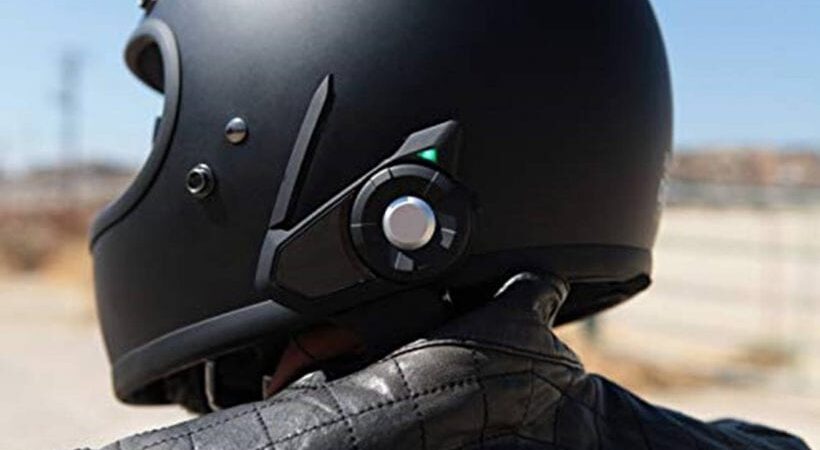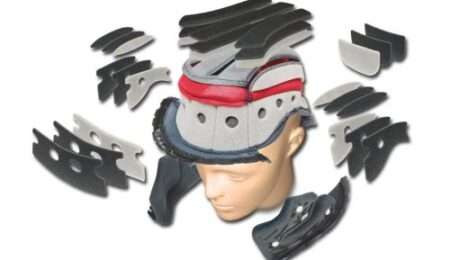Choosing the Right Rider/Passenger and Rider/Rider Communication System
Criteria To Consider When Selecting Your Intercom or Hands-Free Kit
When riding a motorcycle, there’s often a need for a communication system, whether it’s for conversing with a passenger or fellow riders in a group, receiving navigation instructions, taking calls, listening to music, or even connecting with the bike itself, as seen in the latest models with connected TFT screens. But what are the criteria to consider when choosing your intercom or hands-free kit?

What the Law Says
Please note that in order to combat the use of phones while driving/riding, the authorities have increased penalties over the years and progressively restricted options.
Kindly review the regulations and laws regarding hands-free phone usage in your own country.
The Various Communication Systems
In the market, there are two types of intercoms for two-wheel users: universal modules and systems directly integrated into helmets.
Universal Module
The first scenario is the most common, as it takes the form of a small device that can be attached, typically using adhesive or a clip, to the side of any helmet. This device is paired with earpieces that are attached using Velcro to the helmet’s inner lining, and it includes a microphone. For full-face helmets, the microphone is usually wired, while for open-face (jet) and modular helmets, it has a flexible stem. Some of the leading motorcycle intercom brands today include Sena, Cardo, Midland, and Cellularline.
We have recently seen the introduction of more comprehensive devices equipped with a heads-up display, such as EyeLights and Nuviz, which also incorporate a built-in camera.
The advantage of universal devices is that they can be removed from one helmet and used on another, which is a valuable option for those with multiple headgear or those who like to switch helmets regularly. However, proper installation is essential, and it can be time-consuming. Depending on the helmets and the positioning of the padding, there may still be wires hanging (to varying degrees) or they can become disconnected more easily at times.

Helmet-Integrated System
Some helmet manufacturers have also developed helmet ranges that are ready to directly accommodate communication modules without the need for adhesive attachments. Examples include Nolan with its N-Com range, Shark with Sharktooth, and AGV with its Ark system. Moreover, some helmet manufacturers have designed specific helmets to easily integrate particular communication systems, such as Shoei’s Shoei SRL-01 Solo intercom for the Neotec II helmet, or Cardo’s SHO-1 for Shoei and SRC-S for Schuberth.
Others have taken it a step further, as seen with Schuberth, which, starting from the modular C3 Pro and the full-face S2 helmets, directly integrates elements inside the shell, including earpieces, the microphone, and FM antennas. All that’s left to do is add the electronic module, either at the base of the helmet or at the nape, depending on the generation, to access the entire system. Shoei and Nolan also offer this, providing helmets that come fully equipped from the start.

The advantage of integrated systems lies precisely in their integration, both aesthetically and qualitatively, with all components placed exactly right to enhance system performance, especially sound quality. This not only enhances the overall design but also improves interior comfort (nothing worse than an earpiece pressing in the wrong spot or hurting your ears when removing the helmet). However, integrated systems may have limitations in terms of choice and functionalities compared to the specific intercom model one desires.

Intercom to Test Before Purchase
When the helmet isn’t pre-equipped and requires self-installation of the kit, you can find yourself in a situation where the system presses against your head or ears, making it uncomfortable for daily use. The worst-case scenario is when the system painfully pulls on your ears when you remove it, simply because it’s pressing in the wrong place and lacks room to be inconspicuous. The problem is that you often need to remove material from the helmet to make space, which can damage the helmet and potentially reduce protection in the event of an impact later on. In summary, it’s advisable to check, if possible, whether the intercom is compatible with your helmet and head before making the purchase. This emphasizes the importance of testing it in-store before buying.
Using Smartphones as Intercoms
There are a few options to turn your smartphone into a 4G-based communication system using a dedicated app installed on each mobile device. This is what other brands offers with their Talk system.
Hands-Free Kit and Intercom
Firstly, it’s important to distinguish between a hands-free kit and an intercom. While the former aims to pair with your smartphone to access its various capabilities, the latter adds a group dimension by enabling communication with other riders or your passenger equipped with compatible modules.
Communication systems allow you to receive GPS navigation directions, take phone calls, listen to messages, and enjoy your favorite music playlist. Some kits even offer the option to listen directly to the radio through an antenna, bypassing the need for your phone.

Connection is primarily done through Bluetooth, and while some systems feature large, glove-friendly buttons on the device, voice control is becoming increasingly common. Many manufacturers have also developed their own technology, combining Bluetooth with proprietary technology to enhance capabilities.
The capabilities of each device vary, including battery life, intercom range, the number of riders that can be connected simultaneously, and the audio quality of earpieces and microphones. Some devices are equipped with noise reduction features to minimize wind noise, among other things.
Additionally, certain manufacturers have partnered with sound specialists like RCF and JBL to enhance music listening quality inside the helmet.

Functions and Criteria for Choosing a Motorcycle Intercom
Most intercoms offer a range of functions, but you may not necessarily need all of them. Let’s explore the possibilities and selection criteria to find an intercom that truly suits your needs.
Bluetooth
The majority of intercoms operate using Bluetooth technology. However, it’s important to note that there are multiple versions of Bluetooth, each with varying levels of performance in terms of connection quality, data transfer rate, and power consumption (which impacts overall battery life). For instance, Bluetooth 5.2 is now preferred over older versions like Bluetooth 4.1 (not to mention Bluetooth 2.0). Some intercoms still use Bluetooth 3.0 and 4.0. Bluetooth 5.2 has become a standard in intercom technology.
Phone, GPS, Music
The primary functionality involves pairing your intercom with a smartphone or GPS device to access navigation features and make or receive calls. Personally, on a motorcycle, maintaining a phone conversation demands attention that can divert your focus from the road, unless it’s for last-mile directions to a remote campsite or an imprecise address on your GPS.
It’s essential to ensure compatibility with your phone, whether it runs on Android or iOS, although there are fewer compatibility issues in this regard nowadays.

Voice Control and Remote
High-quality systems now include voice control, eliminating the need to manipulate buttons on the helmet (which can be challenging with gloves on while riding). This feature allows you to accept or reject calls without pressing a button.
Some models, such as those from Sena, also come with a handlebar-mounted remote control, which can be more convenient than finding buttons on the helmet.
AM/FM Radio, Mono/Stereo
Certain models feature an AM/FM tuner, either mono or stereo, with or without RDS (Radio Data System), allowing you to automatically tune in to local radio stations for listening pleasure. This can be a valuable addition. In some duo modes, the passenger can also access the rider’s tuner (or not). Additionally, these systems should offer station memory and automatic station search capabilities. The difference between two systems lies in the tuner’s ability to prevent unwanted station skipping. Few things are more frustrating than stations cutting out while riding, even though they work perfectly when you’re stationary at home.”
Sound Quality

Determining sound quality before making a purchase can be challenging. However, similar to traditional speakers or headphones, sound quality can range from very poor (constant crackling and distortion) to good (if not excellent, a level I reserve for car audio). It’s worth noting that with external noise in urban areas, wind, engine noise, and exhaust, listening often reaches its limits beyond 100 km/h, even at maximum volume. This explains why Cardo partnered with JBL, Harman’s audio brand, to enhance audio quality.
Sound quality also depends on how the internal earpieces have been installed. This may seem obvious, but quality is optimized through proper placement, which is why some pre-equipped helmets can offer advantages in this regard.
Ambient Noise Reduction
Introduced by Bose and later by Sony, noise reduction technology helps reduce ambient noise, allowing for clearer audio through the earpieces. While some models incorporate noise reduction systems, not many do. It’s essential to measure the effectiveness of this system, as there can be a significant difference in efficiency between brands.
Rider/Passenger Intercom
In the past, the primary purpose of an intercom was to have conversations with a passenger during a ride. Today, it’s a basic functionality. The key difference lies in the ease of Bluetooth pairing and the ability to maintain that pairing. Early models often took a long time to pair and could lose connection, at best when turned off and at worst during use. Things get even more complicated when you need to pair not only the rider and passenger but also a smartphone or GPS. Many riders recall the frustration of lengthy calls to customer support to achieve this.

Communication Distance
In the early days, motorcycle intercoms allowed communication from bike to bike… as long as you could see each other! You could communicate over a few hundred meters or lose connection at 100 meters due to obstacles like buildings or curves. Today, the best intercoms claim a range of 1.6 kilometers, or even 2 kilometers in optimal conditions. However, most intercoms reach their limits after around five hundred meters.
Motorcycle-to-Motorcycle Intercom
This is the intercom revolution: the ability to not only communicate with one friend but with a group of friends while riding. Of course, this requires that everyone in the group is equipped with intercoms, but with certain models, you can now enable up to fifteen riders to communicate simultaneously (as seen in the Cardo Packtalk model). Some models in other brands work more like walkie-talkies (one person talks at a time) and may not necessarily allow for simultaneous conference-style conversations. It’s important to consider that if one user disconnects, it should not disrupt the communication for others. Older models operated like a chain, where each rider was connected to another rider, and if one link broke, it could interrupt communication for most users. Many intercoms allow connections between two or four motorcycles, but rarely more. The number of connected users also depends on the modes and distance. The best intercoms can support up to 15 riders over several kilometers.
However, how can you maintain privacy with your passenger to discuss the driver who took the wrong turn and added 100 kilometers to the route? Intercoms should also offer a private mode within a group for such moments.

Camera
Yes, some intercoms now include a camera, or action cameras that can be mounted on the helmet come with intercom functionality, like the Sena 10C, which became the 10C Pro in 2019.
Battery Life
I remember the early days when intercoms couldn’t last a whole day, even when on standby for most of the day. Nowadays, intercoms should typically last a full day (8 hours) or even more than twenty hours in active use, with a standby time of one to ten days. However, when you need to recharge everything at night – your phone, GPS, and intercom – and your motorcycle doesn’t have a USB port, battery life becomes a crucial factor, especially if you’re going on a week-long motorcycle trip.
Battery life naturally varies depending on usage, whether it’s listening to music only, regular communication between two users or within a group of ten riders, or mainly on standby.
Some intercoms offer fast charging, allowing you to connect to a portable battery or a USB port during a break to extend your battery life.
Water Resistance
It might seem obvious, but we don’t only ride in fair weather, and electronics are sensitive to water. Some intercoms are resistant to water splashes (but not too much), while others are waterproof and certified as IP67.
Compatibility with Other Brands
Most intercoms are brand-specific, meaning you can only communicate with intercoms from the same brand, and sometimes even with the same model. Some so-called “universal” intercoms allow interconnection with other brands, expanding possibilities, especially when riding with friends. The mention of DMC technology typically indicates more open compatibility options.
Multiple Functions
Many intercoms allow you to make phone calls, communicate with your passenger, and listen to music all at once. However, if you want to simultaneously chat with your passenger, answer phone calls, and listen to music, the number of models that support this is more limited (primarily Cardo with its Gateway system). In such cases, it’s important to check if parallel audio streaming is supported.
The Brand
In the past, we mainly had choices between Cardo and Sena, occasionally Cellularline or Midland as manufacturers, or helmet brands with built-in intercoms like Nolan/X-Lite, Shoei, and Schuberth. Cardo and Sena offer the widest range of models and have established their quality over the years. Today, you can also find distributor brands like Dexter at Motoblouz, Oxford Chattebox, FreedConn, or even lesser-known brands like Boblov, Fodsport, Veetop, available on platforms like Aliexpress , Amazon or from certain equipment manufacturers who aren’t primarily in the intercom business, like Givi with its I303S.
Evolutions
This is nearly the last point, but it’s far from the least important. Will your intercom evolve? Can the firmware be updated? It’s not just about bug fixes but also the ability to pair with new devices or hardware updates, ensuring that your intercom doesn’t become obsolete shortly after purchase.
This partly comes back to the brand. A well-known and reputable brand is more likely to provide long-term support, not just in terms of durability and reliability but also in terms of connections and updates.
Mobile Apps
Can your intercom be configured via a mobile app? This is much more convenient, especially for certain settings. Moreover, a mobile app now allows you to update your intercom without the need for a computer.
Prices
Prices vary widely depending on the brand and the capabilities of each device. You can find basic hands-free kits for less than a hundred dollars (including brands like Cardo with the Spirit), while the most sophisticated intercoms can go over 400 dollars, not to mention duo packs for equipping your passenger. Therefore, you may need to make concessions based on your budget.

More details about:





